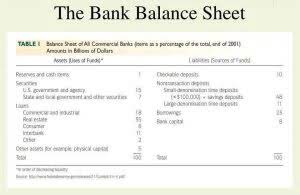Your cart is currently empty!
What Is Double Entry Bookkeeping: A Clear Explanation

Proper record-keeping helps businesses to monitor their financial health, identify areas of improvement, and make informed decisions. By using double-entry bookkeeping, companies can ensure that their financial statements are accurate and complete. The balance sheet, which is one of the primary financial statements, shows the total assets, liabilities, and equity of a company at a point in time. The balance sheet must always balance, meaning that the total assets must equal the total liabilities plus equity. Recordkeeping is handled as single entry accounting and double entry accounting.

Double-entry in accounting software
- The system of bookkeeping under which both changes in a transaction are recorded together at an equal amount (one known as “credit” and the other as “debit”) is known as the double-entry system.
- We believe everyone should be able to make financial decisions with confidence.
- Unlike the double-entry method, single-entry bookkeeping requires you to make one entry per financial transaction.
- Credits increase revenue, liabilities and equity accounts, whereas debits increase asset and expense accounts.
- She has owned Check Yourself, a bookkeeping and payroll service that specializes in small business, for over twenty years.
It looks like your business is $17,000 ahead of where it started, but that doesn’t tell the whole story. You also have $20,000 in liabilities, which you’ll have to pay back to the bank with interest. This is why single-entry accounting isn’t sufficient for most businesses. The accounting system might sound like double the work, but it paints a more complete picture of how money is moving through your business. And nowadays, accounting software manages Law Firm Accounts Receivable Management a large portion of the process behind the scenes.
What is the difference between single entry and double-entry bookkeeping?

Both sides of the equation increase by $10,000, and the equation remains balanced. Because the accounts are set up to check each transaction to be sure it balances out, errors will be flagged to accountants quickly, before the error produces subsequent errors in a domino effect. Additionally, the nature of the account structure makes it easier to trace back through entries to find out where an error originated. As a company’s business grows, the likelihood of clerical errors increases. Although double-entry accounting does not prevent errors entirely, it limits the effect any errors have on the overall accounts. The total amount of the transactions in each case must balance out, ensuring that all dollars are accounted for.
- Liability, Revenue, and Capital accounts (on the right side of the equation) have a normal balance of credit.
- They can identify areas where they’re spending too much money, find ways to increase revenue, and determine whether they’re making a profit or a loss.
- In a double-entry accounting system, every transaction impacts two separate accounts.
- This ensures that the accounting equation remains balanced and that the transaction is recorded accurately.
- The total amount credited has to equal the total amount debited, and vice versa.
- Accountants call this the accounting equation, and it’s the foundation of double-entry accounting.
- A debit is made in at least one account and a credit is made in at least one other account.
How double-entry bookkeeping works

Sure, an example of a double-entry account would be the purchase of inventory on credit. The inventory account would be debited for the cost of the inventory, while the accounts payable account would be credited for the same amount. This ensures that the accounting equation remains balanced and that the transaction is recorded accurately. In Double Entry Accounting, debits and credits form the basis of every Financial Transaction. A debit represents an increase Accounting Periods and Methods in asset or expense accounts and a decrease in liability or equity accounts. Conversely, a credit increases liability, equity, or revenue accounts and decreases assets or expenses.

The asset account “Equipment” increases by $1,000 (the cost of the new equipment), while the liability account “Accounts Payable” decreases by $1,000 (the amount owed to the supplier). You enter a debit (DR) of $1000 on the right-hand side of the “Equipment” account. To balance the accounts, you enter a credit (CR) of $1000 in the “Accounts Payable” account. Double-entry accounting is a system where each transaction is recorded in at least two accounts. This method provides a more complete picture of a business’s finances, and is typically used by larger businesses. Single-entry accounting is a system where transactions are only recorded once, either as a debit or credit in a single account.
Double entry bookkeeping helps businesses to track their cash flow accurately. By recording all transactions in the cash account, businesses can monitor their cash balance and ensure that they have enough funds to cover their expenses. This is especially important for small double entry accounting meaning businesses, which often have limited cash reserves. Double entry bookkeeping is an essential tool for businesses of all sizes to keep accurate financial records.
Example 1: Business Purchases Using Credit
Freshbooks is an online accounting software that is designed for small businesses. It is user-friendly and provides a range of features that make accounting easy. It allows businesses to create and send invoices, track expenses, and manage projects. Double-entry bookkeeping is a bookkeeping system that is widely used in accounting.
- A double-entry accounting system tracks the checking account, which guarantees all activity in the account is recorded.
- See our roundup of the best small business accounting software to find a platform that can help automate your company’s double-entry accounting.
- Financial statements are a summary of the financial transactions that have taken place during a specific period and include the balance sheet, income statement, and cash flow statement.
- By recording all capital transactions, businesses can monitor their equity and ensure that they are meeting their financial goals.
- For comparison, a single-entry accounting system merely tracks items of income and expense without any regard to what bank account income was deposited or how expenses were paid.
- Liabilities represent everything the company owes to someone else, such as short-term accounts payable owed to suppliers or long-term notes payable owed to a bank.
- When a business engages in a transaction, it records both the debit and credit aspects of the exchange in separate accounts.
- Double-entry accounting can help improve accuracy in a business’s financial record keeping.
- At Business.org, our research is meant to offer general product and service recommendations.
- A majority of accounting in all these regards is done in double-entry systems.
- The basic rule of double-entry bookkeeping is that each transaction has to be recorded in two accounts (credits and debits).
A transaction can be a purchase, a sale, a payment, or a receipt of money. A debit is used to record an increase in assets, expenses, and losses, and a decrease in liabilities, revenues, and gains. On the other hand, a credit is used to record an increase in liabilities, revenues, and gains, and a decrease in assets, expenses, and losses. The double entry system is more organized and helps assess the overall financial scenario of a company. Hence, the tax authorities trust and accept the method for tax purposes. However, a single entry accounting method is less trusted and not acceptable for tax computation by the authorities.
Leave a Reply